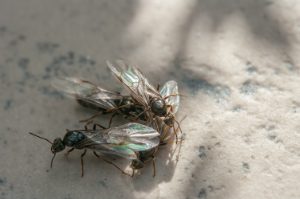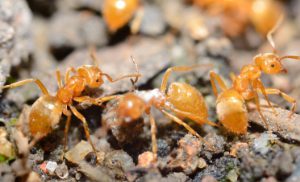Swarms in the Fall are Probably Not Termites
By Zachary Ciras on October 15, 2021.
Winged and Swarming!
Winged and flying insects swarming in or around your home is seldom a comforting experience! Our minds quickly turn to destructive pests such as carpenter ants or termites. Alternatively, too many of us sweep up insects and put it out of our thoughts without knowing what they were. How do we know whether to worry or not? The time of the year in which the swarm occurred may be an indicator.
Termites swarm in the spring… usually
Starting as early as February in most of New England, mature termite colonies will send out reproductive males and females in swarms. These individuals are called alates and their sole purpose is to mate and create new colonies from their parent colony. While alates (swarmers) themselves do not do any damage, they are an indication of a nearby mature colony in the area, feeding on some type of wood. These termite swarmer and small (rice sized, about 3/8”) and dark, almost black with two pair of equal size wings which extend beyond the body, almost double in length. These swarms usually occur in the spring when the soil temperature is generally warm, and often the day after it rains.
A termite swarm can be large and impressive, and can be a helpful signal to call a professional for help. Much less frequently, termites may also have smaller swarms in the fall. One case occurred this year in late September in Eastern Massachusetts. The swarmers emerged from the expansion joint between the basement floor where the washer and dryer are and the wall under the kitchen.
Termites continue working beyond the swarm season until the ground is too cold for them, and because of their cryptobiotic behavior, they work in secret within the wood and behind the walls. Catching a swarm in the spring may help prevent finding damage in the fall.
Carpenter Ants swarm May through August

Group of flying ants on marble in summer
Carpenter Ant swarms generally occur between the months of May and August in New England. The swarms themselves are far less in number than that of Eastern Subterranean Termite swarms, but the size of each individual is considerably larger, with queen ranging from 1/2” to 5/8”. The shape of the body is also distinctly segmented in 3 parts verses the termite swarmer’s almost straight 2 segmented body, and the ant wings are not as long as the body. The wings consist of two pairs of wings, but the fore wings are longer than the hind wings.
See Should You Be Worried About Carpenter Ants?
A different kind of ant
Citronella ants are a fascinating ant. Also known as the later Yellow Ant and prevalent in Southern New England, Citronella Ants are a subterranean species seldom causing pest issues in your home. These swarms can be impressive, with hundreds or thousands, even tens of thousands emerging in a few hours! The swarms can occur any time between April and September, especially on warm, windless days in June and July. We tend to receive calls in May and June reporting the swarms, and then again the September and October when the colony is moving again. Citronella ants effectively farm aphids, scale insects, and mealybugs underground for the sweet honeydew they produce after eating plant sugars. They are non-destructive and are rarely even noticed.

Yellow ants (Lasius Flavus) in anthill, extreme macro shot.
If you do happen upon a swarm or a subterranean colony of the Larger Yellow Ant, give them a sniff should be be feeling brave. They won’t hurt you. They smell like the Citronella plant that is known for repelling mosquitos! Their bright orange color is also a distinguished characteristic which makes these ants more of a keen natural fascination rather than a wood destroying pest.
See Do Mosquito-Repellant Plants Really Work?
Other swarms
Other insects swarm at different times of the year. Stoneflies are one insect category which has a swarm in each and every month of the year. These fly from streams and river and cause no harm, but sometimes alarm when they land on your home. And, they’re great for fly fishing!
I you need help identifying whether or not a swarm is an indicator of a pest issue you should act on, give us a call and we can her you identify your flying friends (or foes!)